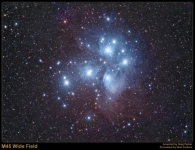Once again, I am about a month early with this object according to Walter Scott Houston’s “Deep-Sky Wonders”, but this is to make sure we get a nice long imaging time on this cluster in an evening.
Everyone knows the question mark shaped open cluster in the sky that is the Pleiades in the constellation Taurus. It is perhaps the constellation with the largest number of associated names as well including Subaru, Freyja’s hens, Matariki, the seven sisters, Tzab-ek, Krittika, At-thuraiya, kilimia, and probably many others. This asterism is one of the closest open clusters to Earth lying at a distance of approximately 135 parsecs or 440 light years. The closest open cluster to the Earth is the Hyades lying some 46.3 parsecs away.
All the named stars of the Pleiades are very bright and therefore very easy to image. We have [where the quantity in brackets is the apparent magnitude]:
- Alcyone (2.86)
- Atlas (3.62)
- Electra (3.70)
- Maia (3.86),
- Merope (4.17)
- Taygeta (4.29)
- Pleione (5.09)
- Calaeno (5.44)
- Asterope (5.64, 6.41 – a double)
My personal favourite is Alcyone, the brightest one in the centre.
The stars themselves are very easy to image, but what we’re all after in our images of the Pleiades is the beautiful blue reflection nebulosity that fills this entire region. Blue reflection nebulae are basically clouds of dust, and the reflection nebula associated with the Pleiades is no different.
What is interesting is that this dust cloud is not associated with the formation of the stars themselves, but is an unrelated cloud of dust that the Pleiades just happen to be passing through at this time. This nebulosity is rather faint, and it takes long subs to bring out the fainter regions, long subs of course means the stars themselves are going to be overpowering, and some deft processing is required to keep them under control. Also, the extent of the Pleiades at something like 2 degrees means your imaging system needs a substantial field of view or you will need to resort to a mosaic.
The Sky 90/M25C’s field of view at 3.33 by 2.22 degrees comfortably takes in the whole cluster and surroundings in a single frame. It is a good idea to take a series of frames at different sub-exposure times so that when you layer the different frame sets together you can bring out the faint nebulosity and at the same time keep the diameter of the stars down. So I suggest, for an imaging system like mine, you take sets of subs ranging from 3-minutes up to perhaps 20-minutes in order to pick up the faintest reflection nebulosity.
The accompanying single frame Sky 90/SXVF-M25C image was taken in this way using 13 subs at 10-minutes per sub, 13 subs at 6-minutes per sub, and finally 7 subs at 20-minutes sub. This data was then combined with an earlier 4-frame Hyperstar mosaic where each frame was a total of 70-minutes using 1-minute subs. Modestly I would say that this is one of the deepest amateur images of the Pleiades I have seen to-date. Can you go deeper still?



Superb!! As always.
I reckon that if you image any deeper you’ll get the microwave background 🙂
I still find it hard to believe that you can get depth like that in essentially the same skies as I have. Incidentally, I believe the nearest open cluster is the Hyades at 46.3 or so pc.
Thank you for the correction on the nearest open cluster 🙂 We’ll get that changed. As for the depth of the image – the magical Hutech IDAS LP filter really is worth its weight in gold. Seriously, out of all the kit I have, this was probably not only the best value for money – but also the most effective optical element I own.